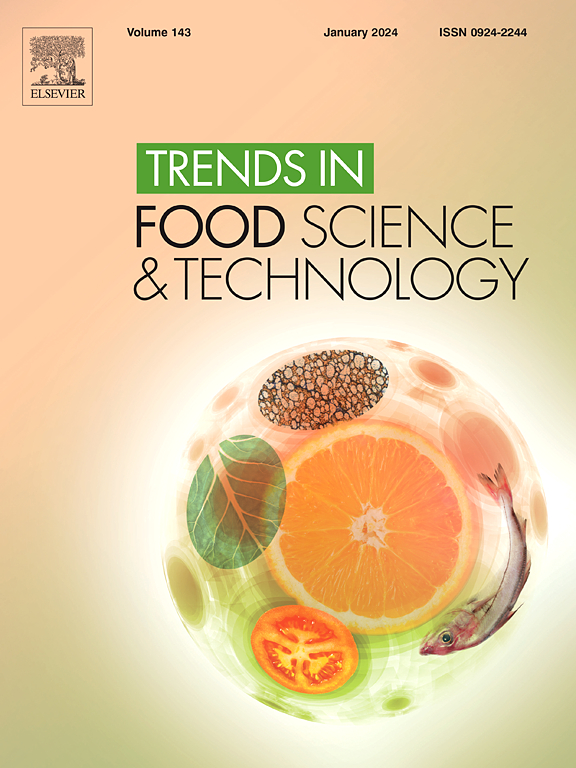Revolutionizing cryopreservation: Bio-based cryoprotectants, mechanisms, and advanced applications for sustainable pan-food systems
IF 15.1
1区 农林科学
Q1 FOOD SCIENCE & TECHNOLOGY
引用次数: 0
Abstract
Background
Cryoprotectants, when applied to pan-food areas, can reduce frozen damage and quality degradation. Although traditional cryoprotectants such as saccharides, glycerol, and dimethyl sulfoxide (DMSO) have been widely used, with the development of bio-based concepts, biocompatible and non-toxic cryoprotectants naturally existing in nature such as antifreeze proteins (AFPs) and natural deep eutectic solvents (NADESs) have gradually become more promising choices for cryopreservation and frozen food storage.
Scope and approach
This review focuses on the traditional and emerging bio-based cryoprotectants in pan-food applications, specifically reviewing the cryoprotective mechanisms and applications of saccharides, AFPs, and NADESs. The fundamentals and the updated information regarding the action mechanisms of the cryoprotectants are concluded, and the current research advances concerning the applications in pan-food areas using these cryoprotectants are summarized and discussed.
Key findings and conclusions
Disaccharides/oligosaccharides influence ice crystal growth by interacting with water molecules around proteins or lipids through water substitution theory, vitrification theory, and water entrapment hypothesis. Polysaccharides modulate the ice crystal growth behaviour through the ice-binding mechanism, and their molecular structures and molecular weights can significantly affect the ice recrystallization inhibition (IRI) activity. AFPs from different sources change ice crystal morphology, exhibiting thermal hysteresis, and IRI activity in different degrees following “adsorption-inhibition” mechanism. NADESs show excellent capacities for freezing point depression and IRI due to their temperature-responded hydrogen-bonding supramolecular networks. As emerging cryoprotectants, AFPs and NADESs possessing non-toxicity and biocompatibility will show great potential in the future food mega-industry.

革新低温保存:生物基低温保护剂,机制,以及可持续泛食品系统的先进应用
当冷冻保护剂应用于泛食品领域时,可以减少冷冻损害和质量退化。虽然传统的冷冻保护剂如糖类、甘油、二甲亚砜(DMSO)等已被广泛使用,但随着生物基概念的发展,自然界中天然存在的生物相容性和无毒的冷冻保护剂如抗冻蛋白(AFPs)和天然深共熔溶剂(NADESs)逐渐成为低温保存和冷冻食品储存的更有希望的选择。本文综述了传统的和新兴的生物基冷冻保护剂在泛食品中的应用,重点介绍了糖、afp和NADESs的冷冻保护机制和应用。综述了低温保护剂的基本原理和作用机理的最新研究进展,并对低温保护剂在泛食品领域的应用研究进展进行了总结和讨论。通过水取代理论、玻璃化理论和水包裹假说,双糖/低聚糖通过与蛋白质或脂质周围的水分子相互作用来影响冰晶的生长。多糖通过冰结合机制调节冰晶生长行为,其分子结构和分子量对冰重结晶抑制(IRI)活性有显著影响。不同来源的AFPs改变冰晶形态,表现出不同程度的热滞后和IRI活性,遵循“吸附-抑制”机制。由于NADESs具有响应温度的氢键超分子网络,因此具有优异的冰点降低和IRI能力。AFPs和NADESs作为新兴的低温保护剂,具有无毒性和生物相容性,将在未来的食品大工业中显示出巨大的潜力。
本文章由计算机程序翻译,如有差异,请以英文原文为准。
求助全文
约1分钟内获得全文
求助全文
来源期刊

Trends in Food Science & Technology
工程技术-食品科技
CiteScore
32.50
自引率
2.60%
发文量
322
审稿时长
37 days
期刊介绍:
Trends in Food Science & Technology is a prestigious international journal that specializes in peer-reviewed articles covering the latest advancements in technology, food science, and human nutrition. It serves as a bridge between specialized primary journals and general trade magazines, providing readable and scientifically rigorous reviews and commentaries on current research developments and their potential applications in the food industry.
Unlike traditional journals, Trends in Food Science & Technology does not publish original research papers. Instead, it focuses on critical and comprehensive reviews to offer valuable insights for professionals in the field. By bringing together cutting-edge research and industry applications, this journal plays a vital role in disseminating knowledge and facilitating advancements in the food science and technology sector.
 求助内容:
求助内容: 应助结果提醒方式:
应助结果提醒方式:


